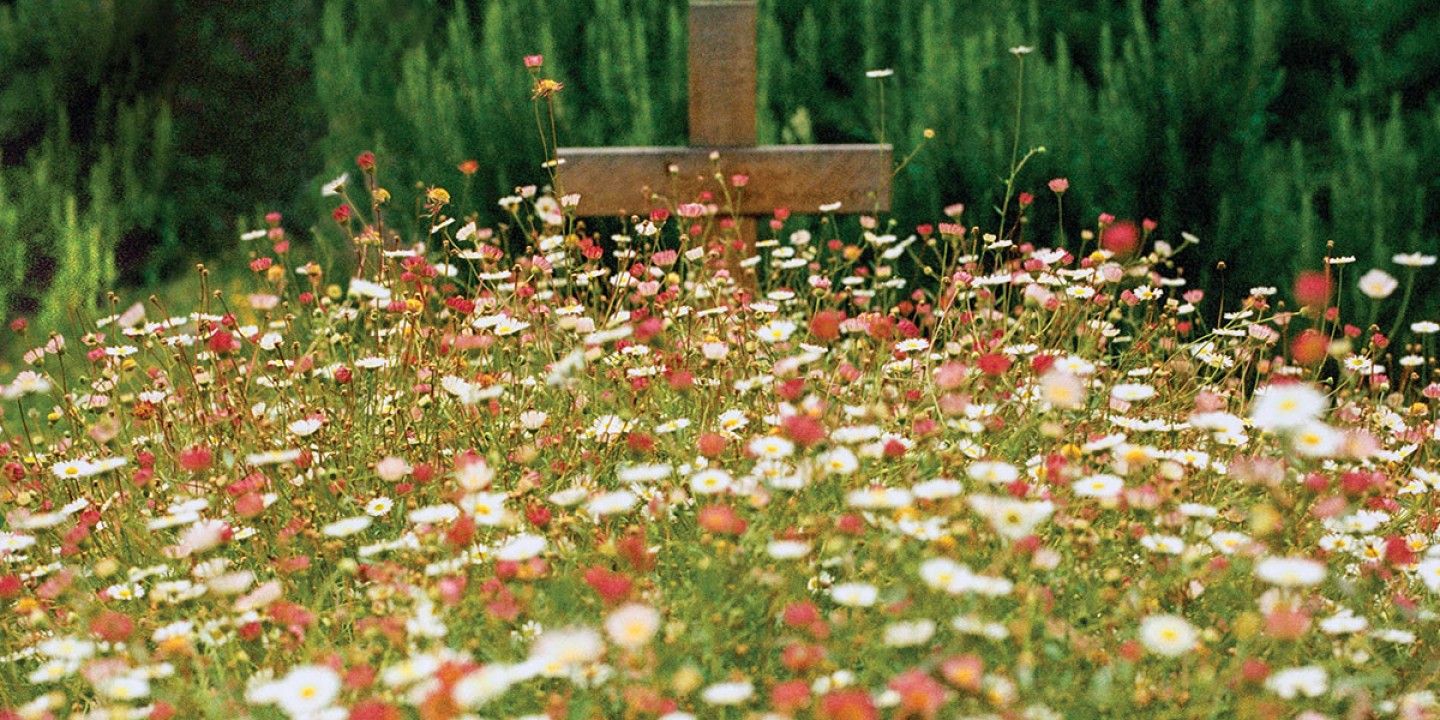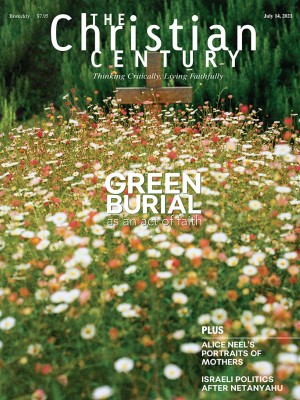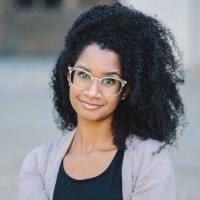Green burial as an act of faith
A growing number of Christians are embracing natural burial practices.

When Beth Hoeltke starts talking about death, her face lights up and her eyes begin to sparkle.
“I’ve actually been called the Death Lady,” she says, laughing heartily enough to make the tiny silver hoops on her ears swing. “I wouldn’t call myself that. I like to discuss death and what it means and how we should talk about it—but I’m not the Death Lady.”
Hoeltke, who leads the graduate school at Concordia Seminary in St. Louis, started writing about death about three years ago, motivated by the connections she was seeing between her academic research in the theology of creation and what seemed to her to be a gap in how Western culture addresses—or rather, doesn’t address—the way we die.
Read our latest issue or browse back issues.
We have become so afraid of death, Hoeltke says, that we almost can’t bear to have it in our presence. She points out that, often, the first logistical task we take on after a loved one has died is to call the funeral home and have them remove the body.
“They’re cared for by a complete stranger,” she continues, “and that concept, in my mind, just didn’t sit right. If God has provided us this amazing creation in which we participate, then there might be a better way to also bury our loved ones in that creation.”
Hoeltke started looking for a more Christlike alternative to conventional US burial practices—and she found it in the resurgent green or natural burial movement.
Broadly speaking, green burial means caring for the dead with minimal environmental impact. That usually includes forgoing any chemical embalming, opting for a shroud or a biodegradable coffin instead of the more popular steel or fiberglass, and skipping the cement vaults that typically enclose a coffin in the ground. It can also mean being buried in a cemetery that practices land conservation efforts.
And for some people, like Hoeltke, natural burial also involves a more participatory burial process: washing and dressing your loved one’s body at home, accompanying them to the grave site, physically laying them into the ground, and then fully covering their body with dirt.
“It’s a really beautiful experience. And I know that sounds crazy, but I’ve seen the beauty of what can happen,” Hoeltke said. “I think the loss that you deal with after a loved one dies becomes a little easier in a sense, because that reality of death is in front of your face. When society takes death out of the picture of life and hands it off to someone else, we’re missing that beautiful connection in the ability to love our loved ones through death.”
Fundamentally, of course, natural burials are nothing new; up until the 1930s, this is how almost everyone in the United States was buried—and it’s how many people around the world continue to be buried today.
This contemporary resurgence of green burials within the dominant Western culture began in 1993 when Ken West, head of bereavement services for the city of Carlisle in North West England, opened up an area of grassland bordering the municipal cemetery for burials. His goal was to find a way to integrate wildlife with burial, so he also offered families the option of planting an oak tree at the grave site instead of erecting a gravestone.
The idea took off.
When three British researchers conducted an independent survey of burial grounds in the United Kingdom in 2013, they found that 268 natural burial sites had been created in the two decades following West’s initial project. The United States got its first green cemetery in 1996—Ramsey Creek Preserve in Westminster, South Carolina—and today there are more than 160 green burial sites in the United States.
The Green Burial Council, founded in 2005, sets industry standards for natural burials in North America. They offer certification for green cemeteries—including certifications for conventional cemeteries that have designated green burial spaces—funeral homes, and products.
The council also offers educational services to both the general public and to deathcare professionals. Since 2010, they have awarded the Green Burial Council Leadership Award to people or organizations that have demonstrated innovation and commitment to sustainable deathcare, and in 2020 they held the first of what they hope will be an annual conference.
The popularity of natural burials spans cultural, racial, and religious demographics. When the National Funeral Directors Association surveyed people about their interest in 2017, more than 58 percent of respondents said they had an interest in exploring green funeral services.
Among religious folk, green burial seems to be most popular with Catholics. Ann Hoffner, who writes and edits the illustrated Natural Burial Cemetery Guide, told the Century that 17 of the cemeteries in her book are Catholic—that’s about 10 percent of all the green cemeteries in the country. By comparison, she said six of the nation’s green burial sites are Jewish, three are Quaker, and one is Episcopalian.
Fran Donnelly, a Sister of Charity of the Blessed Virgin Mary, has spent the last 13 years serving as the director of life transition ministries for the Catholic Cemeteries, a 165-year-old private cemetery organization in Minneapolis-St. Paul. Two years ago, they converted 30 acres in one of their five cemeteries into a natural burial site after a local funeral director encouraged them to get ahead of what he saw as an inevitable trend.
So far, Donnelly said, they’ve been encouraged by the results. They’ve already done about a dozen natural burials, and four of the eight natural burial sections in the cemetery are already sold out. They’ve also heard from local pastors that the people in their pews remain interested.
For these reasons, Donnelly is convinced that natural burial is here to stay. “I don’t think it’s going to be the next cremation, statistically,” she says, “but then again, this is how cremation started out—real slowly, and most people thought it was weird. And look at us now.” Today, she notes, a majority of people in the United States who die are cremated.
Donnelly thinks Catholics are especially open to natural burials because the practice combines the importance of physically burying the dead, as taught in the Catholic catechism, with the care for the earth laid out in Pope Francis’s 2015 encyclical Laudato si’.
“It’s consistent with what we profess,” she says.
But there seems to be growing interest among liturgically minded Protestants as well, both progressive and conservative.
Benjamin Stewart, associate professor of worship at the Lutheran School of Theology at Chicago, writes and speaks extensively about green burial. He says that for many Christians, getting turned on to the idea of how death can be different is almost like having a religious conversion.
After he gives a talk on green burial, he says, a flood of people usually rush around him, wanting to get on board immediately—even if they’d never heard of green burial before his presentation.
“For those who have grown up hearing that phrase, ‘Earth to earth, ashes to ashes, dust to dust,’ we recognize, in some ways—that’s our name being called,” he continues. “And our current funeral rites don’t ritualize that name. They’re doing something else.”
In St. Louis, Concordia Seminary asked Beth Hoeltke and her writing partner, Kent Burreson, to create a natural burial Bible study, and in January 2020, they published Natural Burial: The Final Journey—a free, downloadable six-week study—along with an accompanying burial planning guide. (While many people use the terms “natural burial” and “green burial” interchangeably, Hoeltke and Burreson prefer “natural” because of the stigma “green” carries for some conservative Christians. Plus, Hoeltke says, “natural” is more accurate anyway.)
Both Hoeltke and Burreson’s Bible study and their natural burial talks have been wildly successful, especially among young pastors. “The younger they are, the more they like the topic,” Hoeltke says. “So it’s a cultural shift, which I think is kind of cool.” She and Burreson are planning to write a book on natural burial next.
That Christians would be so open to green burial, once they’ve been exposed to the concept, makes perfect sense to both Hoeltke and Stewart. Many aspects of it mirror Christian liturgy so well that they really are perfect companions.
Take baptism, for example.
“As a Christian, we are baptized into Christ,” Hoeltke says. “We are wearing the garments of baptism and are cared for and loved by our families who are bringing us in baptism. If you take that theme of baptism into burial, we’re repeating the process again. We care for them and wash them, and we bring them full circle.”
Stewart says that even bringing a beloved’s body to their grave involves baptismal symbolism. “That action of carrying a body—that its last journey is not under its own power—to me that’s baptism,” he said. “Our last journey is by grace.”
Stewart says wildlife often makes an appearance at a green burial—a hawk flies overhead or deer stop nearby—and this is regularly perceived by the bereaved as a sign of God’s reassurance, even in their grief. He says that so many people have told him these kinds of stories that now he can actually tell when someone is about to share one with him. He’s also experienced it himself.
“I think there’s a kind of tough honesty about putting a body into the ground and seeing them covered with dirt. Like, that’s really hard, but it’s also honest,” Stewart says. “But then all of that honesty is also met with the beauty and richness of ongoing life, and it becomes a comfort to us in death—a sign of God’s ongoing goodness to us.”
Like Hoeltke, Stewart thinks dominant Western culture—including its iterations of Christianity—has not prepared us to deal well with death. He observes that the liturgical resurgence of the late 20th century saw Christians across the country installing large baptismal fonts and recovering the embodied action of sharing the peace—but that resurgence largely passed over funeral rites.
“In American cultures, the ways that we’ve been given to honor our beloved dead have to do with preservation of the body—almost enshrining them and preserving them,” he says. “The memorialization of death is about the maintenance of something. So, in order to do that we want to fight against decomposition.”
In short, he says, we’ve been handed lots of cultural tools that allow us to take ourselves out of the earth-to-earth story. Stewart points out that in some funeral rites, right before there’s any mention of “earth to earth,” there’s a line about eternal life and “sure and certain resurrection.” That cheek-to-cheek juxtaposition suggests to him that what Christians are really trying to do—on both an intellectual level and an emotional one—is to give a cursory nod to the idea of death but then return quickly back to life. Death and resurrection, he says, is a theological knot some people have yet to untie.
“What happens to me when I die? Do I just return to the earth and that’s it? What does resurrection mean? And I would say, in a lot of our churches, there’s some interesting silences around that.”
It would help, Hoeltke says, if the church could get better at talking about death. That’s the reason she and Burreson, before taking on natural burials as a writing topic, first wrote about death in their 2019 book Death, Heaven, Resurrection, and the New Creation.
“We decided it’s time to bring death to the forefront,” she says. “We need to talk about it, especially as Christians. Because if nobody else can talk about death, we can. And death had purposefully been put in the back corner. It’s hidden from us.”
Despite her natural burial advocacy, Hoeltke wants to be clear that she is not speaking against conventional death care. “We’re not saying there’s anything wrong with it,” she said. “We just think there’s a way that looks more Christianlike—more toward following Christ’s death and resurrection.”
But because she sees such an inherent link between natural burial and Christianity, it’s somewhat disappointing to her that there aren’t more Christians working in natural death circles.
In recent years, death doulas or death midwives have begun to offer an important service for those wanting to take on for themselves the responsibility of preparing a loved one’s body for burial. These doulas or midwives can walk alongside a family and help them properly wash, dress, and position a body. They can help friends know what sights, smells, and sounds to expect.
It’s an indispensable service, says Hoeltke, but so very few Christians are in the profession that she’s considering becoming a death doula herself. It bothers her that as Christians enter into the grieving process, the person who is walking them through it might not be able to meet their spiritual needs appropriately.
“Even when you go to funerals these days, the people that are directing the funeral are no longer the pastors, they’re funeral directors,” she says. “We’re Christians! Christ should be leading the way into our churches and into the graveyard.”
Yet people, Christian or otherwise, hoping to have a green burial are swimming against the cultural stream. Outside communities where natural burial is the norm—the Amish, certain Jewish and Muslim communities—finding the resources for natural burial takes work and preparation.
Hoeltke likes to remind people that embalming is not a necessity. “Embalming is not a state requirement—in any state,” she says. Bodies can be easily and safely preserved in a hospital or mortuary refrigerator. But you have to know who to call to find refrigerator space. And there might not be a natural burial site near you—or if there is, they might not have space.
Ann Hoffner, who writes the green burial guide, notes that some municipal cemeteries with designated green spaces have to turn people away in order to ensure they have enough space for their local constituents. She also says that she had to take some cemeteries out of the second edition of her book because they’re now full.
Stewart says that, ideally, he’d like to be buried in a grove, under a tree and by a stream. But he knows that might not be possible. So he gives the same affirmation to his family that he gives to the audiences at his natural burial talks: our culture makes natural burial really tough, so don’t put undue pressure on yourself to do it perfectly.
“If you pump me full of chemicals and put me in a big ol’ metal vault coffin,” he says, “I know that I’m still held in God and really—ultimately—still held in the earth.”
A version of this article appears in the print edition under the title “Dust to dust.”






